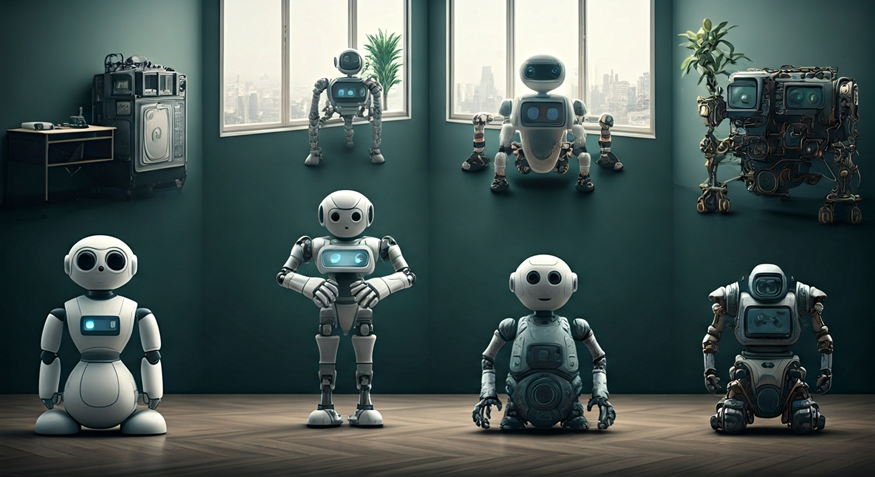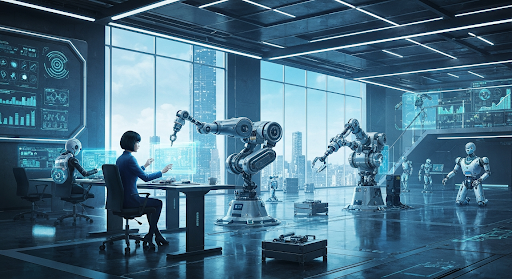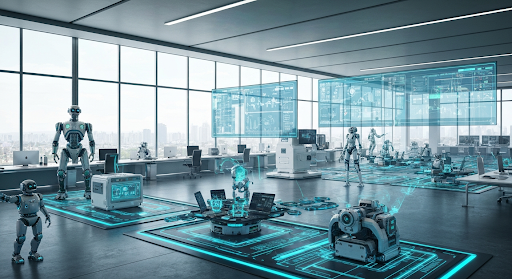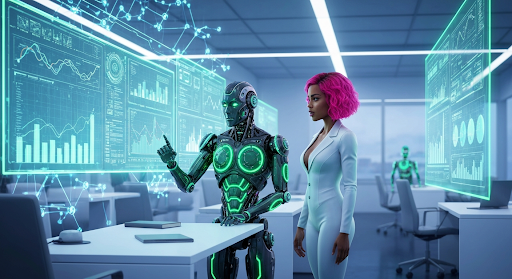The Future of Work: Robots Automation in Daily Tasks
Key Highlights
- Robots and automation are changing the way we live and work every day in homes and offices all over the world.
- Service robots, industrial robots, and collaborative robots each help with different jobs.
- Artificial intelligence and robotic process automation (RPA) are used to do repetitive tasks faster and help make work go more smoothly.
- In the American workforce, job roles are changing, and people need to learn new skills to keep up.
- Some people worry about losing jobs because of automation, but it also brings new chances in computer science and robotics.
- Many industries are moving everything online because of automation software and more use of RPA implementations.
Introduction
Robots and automation are changing the way we do the same things again and again every day. The use of robotic process automation and artificial intelligence is growing fast. Both help make things faster and easier, not just in factories, but at homes too. Robots can run factory lines and help run digital workflows. This kind of process automation saves time, cuts down on human error, and helps make the work better. With these new systems, businesses find more chances to grow and do well. People also find that their daily lives get easier, and they can get more done. In this article, you will see how robotics and automation are making our lives different now.
Understanding Robots and Automation in the Modern Workplace
Modern workplaces use robotics and automation technology to drive change. With robots now taking care of many manual and physical jobs, things get done faster. Software automation helps by taking on virtual tasks, so business process automation is more effective in many areas. You will see this in the way businesses handle materials, and in how customer service can work automatically. Organizations are changing the way they work, using new tools that help them work better.
Automation technology, at its heart, lets people step away from small, repeat jobs. This means there is less need for human intervention in certain work. People then get more time to work on important tasks. These new tools are changing the business process as a whole. The workplace is seeing higher productivity, as well as more focus on accuracy and getting things right the first time.
Defining Robotics and Automation
Robotics brings together engineering and computer science to build programmable machines. These machines can do many kinds of tasks. Physical robots may work on their own or need human intervention. They use things like sensors and actuators to move in the physical world and handle what is in front of them. You can find these physical robots in industries like healthcare or manufacturing. They help with complex tasks, doing them with a lot of precision.
Automation technology is about making short work of everyday work that people used to have to do. This covers physical robots that handle material handling as well as process automation and software automation, where virtual tasks like setting up appointments can be completed by a machine. These steps in automation help with efficiency. They also make work faster and lower its cost. This is good for companies who want to grow and do more with less.
Robotics deals with active work in the physical world. Auto technology, though, goes farther. It also covers tasks in a virtual world, including software automation and process automation. All this helps people by giving more time, using fewer resources, and lowering energy use. These new ways to connect humans and machines make life easier and work flow better.
Key Differences and Similarities
Robotics and automation both try to make work more efficient, but they are used in different ways. Process automation uses advanced software to handle virtual tasks. Robot automation means putting physical robots in places like factories. Both help companies by making jobs easier and reducing the need for people to do the same things again and again.
There is something similar in both robotics and automation. They both need instructions or programs to work. Physical robots follow algorithms to do physical processes. Software automation uses RPA tools to carry out work with virtual tasks. In both, people still need to step in sometimes, to check that everything is right and to solve problems when the system cannot.
Even though there is some overlap, these tools work best in different places. Physical robots are used mostly in factories and other real-world settings. Process automation changes the way people handle office work. When hardware and software come together like this, these systems give better efficiency and can save money for people and companies.
Types of Robots Used in Daily Tasks

There are three main types of robots changing the way people work today. These are industrial robots, collaborative robots, and service robots. Industrial robots are made for jobs that need to be done the same way many times. They work best in places like factories. These robots can do things like welding and putting parts together, which helps to raise productivity.
Collaborative robots, often called cobots, are built to work with people. You will find them working side by side with humans in jobs such as logistics and healthcare. They support human workers and adjust quickly to new tasks.
These types of robots help make day-to-day jobs easier. Industrial automation and customer services are getting better with them. By picking the best robotic solution, companies see more safety, the ability to grow, and better ways to save money.
Service Robots in Homes and Offices
Service robots are made to help with daily jobs in offices and homes. They use advanced software solutions to do work as well as people. These robots are good at doing many things at once and help people be more productive, especially when there are a lot of repetitive tasks.
For offices:
• Service robots handle customer service jobs by using chatbots and automated helpers.
• They also do material handling, so the work of keeping up with inventory and deliveries gets easier.
For households:
• Vacuum robots do cleaning tasks, so homeowners do not have to, making life more simple and easy.
These smart systems mix human work with automation. They help everything work together well, for a smarter way of living.
Industrial and Collaborative Robots
Industrial robots are now important in many making things jobs. They take out human error and give great precision. These robots help to raise output by doing jobs like putting parts together or checking things where you need every item to be the same. Industrial automation can really change jobs in places where repetitive tasks are the main work.
Collaborative robots, also called cobots, are made to work with people. These robots are user-friendly and help humans right by their side. Unlike industrial robots, cobots join in with people to do tasks like helping in moving items, kids' surgery in hospitals, and handling simple making things work.
Industrial robots and collaborative robots work well together. They help to fill in each other’s gaps, so a company can grow its work and lower risks that often come by human intervention. When a business uses one or both types of robots, it can often make its work faster and better in many ways.
Automation Technologies Shaping Everyday Life
Automation technologies make daily tasks easier and bring big changes to many industries and your personal life. You can see this in things like financial services. They use new automation software to speed up process mining and data analysis. These tools take over tasks that people do over and over again, helping to make sure everything is done right.
With digital transformation, systems powered by artificial intelligence and automation software help people and businesses manage their work better. This can be for big business resource tasks or for using smart gadgets in the home. No matter where you use it, automation is a big help.
Smart Devices and AI Assistants
Smart devices and AI assistants help bring automation into homes and workplaces. These devices use artificial intelligence to follow voice commands, set reminders, and make it easier for people to talk to each other or stay connected. With machine learning, the systems can get better at their jobs over time.
Examples include:
• Using image recognition on phones to find objects in photos or improve how pictures look.
• AI assistants can help with daily plans, tasks, and give weather alerts.
These smart devices support human judgment and make people more efficient. They make work and daily life easier each day, while also helping people stay connected in smarter ways.
Software Automation in Routine Processes
Software automation helps make boring and repeated tasks in digital spaces easier. The use of RPA bots is great for handling complex workflows in financial services or communication tools. Advanced automation software lets businesses scale up process automation. This also lowers the risk of human error and helps the work get done faster.
| Automation Type | Functionality |
|---|---|
| RPA Bots | Handles data entry through virtual screens and smart process automation. |
| Financial Service Automation | Helps with repeated jobs, like checking documents and following rules. |
| Chatbot Solutions | Chatbot Solutions Improves how customers interact by using smart reply tools. |
Companies that use these tools for business process automation, software automation, and process automation get more accurate results. They also see a boost in how much they can get done, making the business process work better.
Impact of Robots and Automation on the American Workforce
Automation technology is changing jobs in America. It does not just take jobs away. Instead, it changes what people do at work. When robots handle the tasks that get repeated over and over, people get to do other things. They can focus on jobs that need new ideas and more planning.
As businesses work on digital transformation, they look for people with new types of skills. This helps connect older ways of working to the new ways that use more technology. When things run better and faster with this kind of setup, people can move to jobs where you do less by hand. They start working with automated systems in a smoother way.
Job Transformation and New Skill Requirements
The rise of robotic automation is changing jobs. People now need to learn new skills. As digital transformation spreads, it is important for workers to know more about computer science and analytics.
There are some things that automated systems cannot do on their own. Human judgment is needed in these areas. For example, people are needed to program robots or to fix problems in process automation. This makes sure that humans stay important.
To handle new technologies in the future, workers have to keep learning. Continuous upskilling is how we get ready for how automation will shape the workplace.
Addressing Concerns: Job Loss vs. Job Creation
As more companies use automation technology, people worry about losing jobs, mainly with work that is repetitive or old-fashioned. But this is not the whole picture. Automation also helps create the chance for new jobs, often in places where human judgment and advanced robots work together.
Key areas of job creation:
• There is rising need for technical roles, including computer science specialists.
• Programming, taking care of, and growing businesses that help robotics are also growing fields.
If businesses keep working on business process digitization, people and machines can work together. This makes workplaces better, more efficient, and helps them grow.
Conclusion
To sum up, the way we work is changing fast with robots and automation becoming a big part of everyday life. This change is making us do simple tasks in new ways. It is important for all of us to learn what these technologies can do and what types of robots are coming into our lives.
Some people are worried that these changes may take jobs away. But there is also a chance for new jobs to be created, and for jobs we know to change into something else. So, we need to get new skills and learn fresh ways to work if we want to keep up and make the most out of this shift.
If we keep ourselves informed and ready, we can use the best parts of automation and robotics to help us work better. This will help us keep a good balance in the workforce. If you’re interested in what this can mean for your business, feel free to reach out for a talk or a meeting!
Frequently Asked Questions
Will robots completely replace human workers?
No, robots will not completely take over jobs from people. Robotic automation can take care of simple and repetitive tasks, but people are still needed. Human intervention is important when it comes to solving problems in creative ways and for many jobs involving artificial intelligence. Automation technology can help people do their work better, but it does not make them less important. Instead, it adds to what people can do.
What are some common examples of automation at home?
Examples of this are voice-controlled smart devices, programmable thermostats, and automatic home security systems. Automation software can give many virtual benefits. In the physical world, tools like robotic cleaners help you with chores at home without needing much work from you.
Can small businesses benefit from robotics and automation?
Yes, small businesses can use robotics and automation to help things run better. Software robots and RPA tools help with process automation. They make business process automation simple. This lets small businesses lower their costs and do repetitive tasks in an easier way. With these tools, they can make a business process faster and more efficient.
How can workers prepare for increased automation?
Workers can spend time to get new skills in computer science. They can also work on jobs where human judgment is important. Another good idea is to learn about process mining. If you join a digital transformation course, you will be ready for jobs that come from automation. This helps people stay up-to-date and able to find new chances.
What industries are most affected by robotic automation in the U.S.?
Industries that get the most impact are manufacturing, where they use industrial robotics, and financial services, which now work with RPA bots. Customer service teams also often use automated chatbots to help people. Material handling and logistics have brought in advanced automation technologies.This helps their operations run more smoothly with new ways to get the work done.



